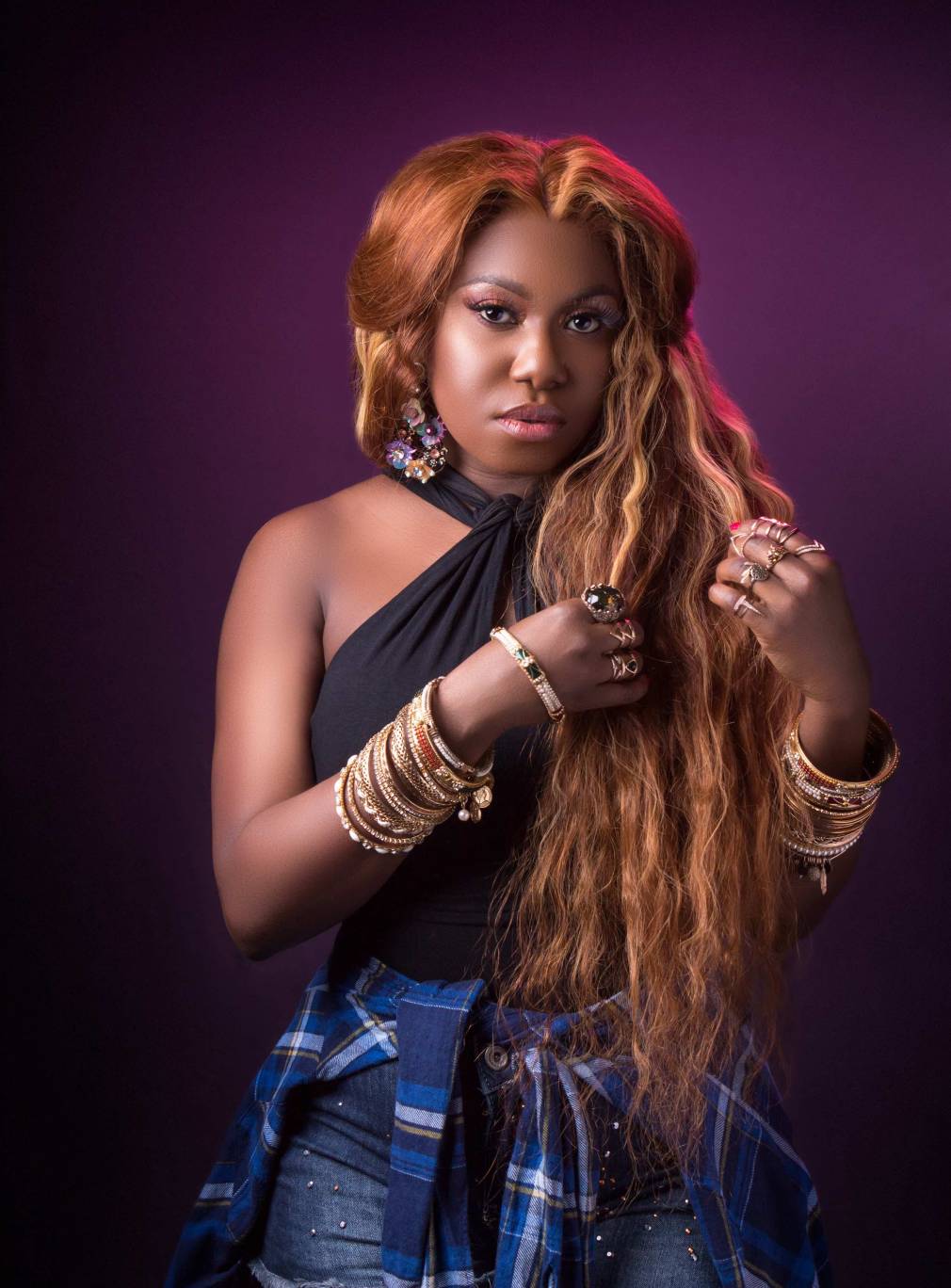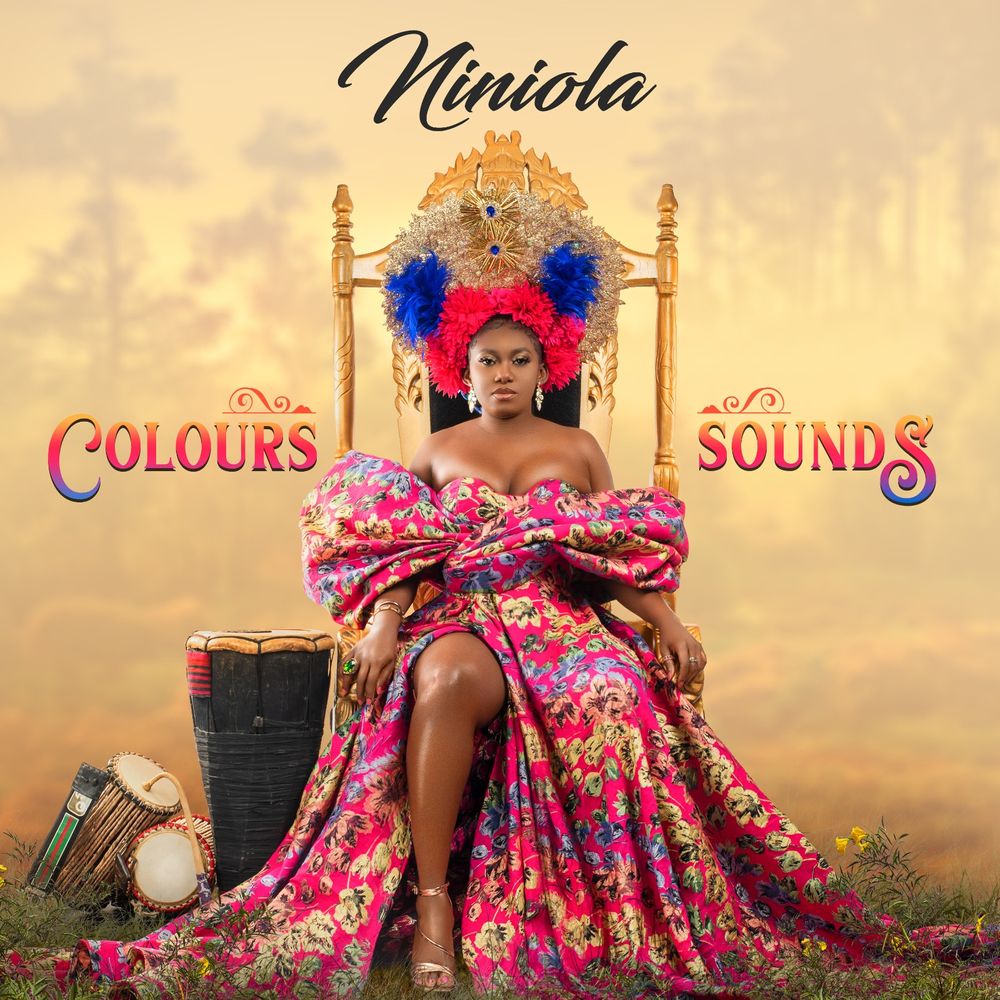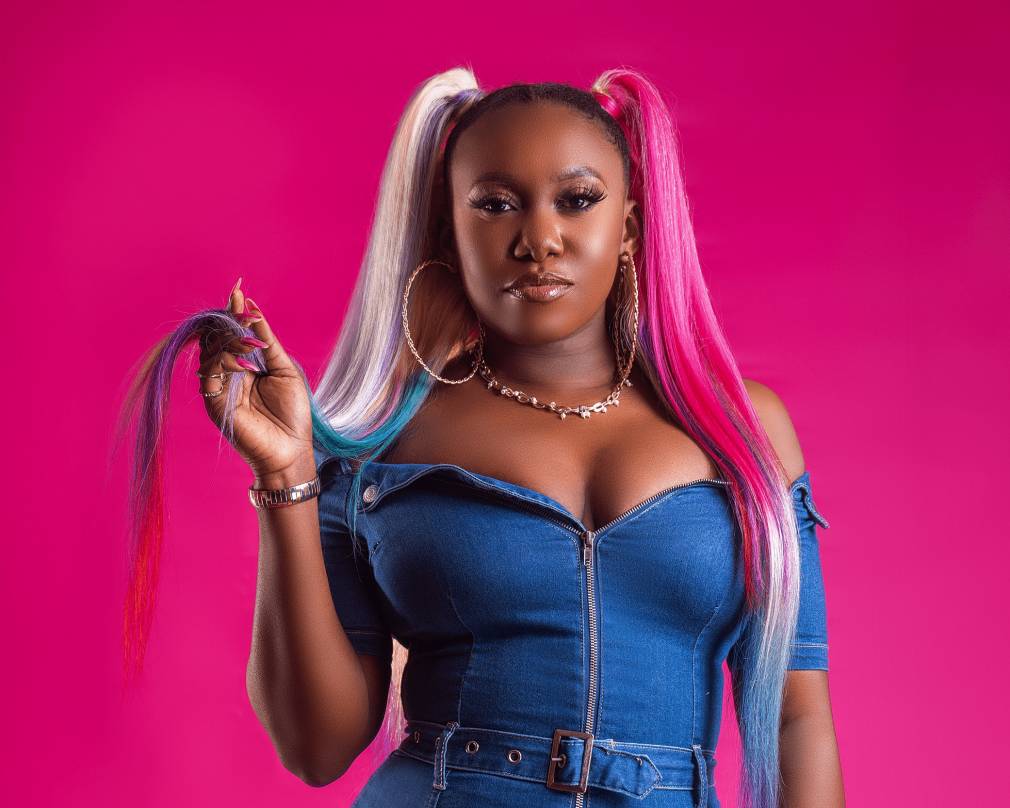Marketing and promotion of Colours and Sounds has been put on the back burner as the singer lends her voice to the #EndSARS movement, a protest against police brutality in Nigeria. For Niniola, the safety of her fellow citizens is just as much of a worthy cause. “I’m human first and also Nigerian and everything happening has affected me too,” she says.
Born Niniola Apata, the Queen of Afro House grew up an introvert, seeking solace in her parents’ record collection. However, that didn’t last long, and by the time she was in high school she was running a lunchtime show mimicking her favorite singers.
Niniola’s engrossment in music took a professional turn after auditions with renowned talent shows like Idols West Africa, X-Factor and Project Fame where she eventually emerged as the third runner up.
Not one to rest on her laurels, Niniola leveraged her sparse appearances to the fullest in order to pursue a long-term career in music. While singles like “Ibadi”, “Soke”, “Shabba” introduced Niniola locally, pan-African collaborations like “Mbilo Mbilo” with East Africa’s Eddy Kenzo put her on the continental map, winning Best Collaboration at the All Africa Music Award (AFRIMA) in 2016. “Maradona” became the tipping point for Niniola’s global domination, spending thirteen weeks on South Africa’s Metro FM chart; six weeks at #1, with cosigns from Beyonce, Drake, Timbaland, DJ Snake, etc. Niniola became the first Nigerian female artist to amass over a million monthly listeners on Spotify. She was nominated for Best African Artist at South African Music Awards in 2017 and Viewers Choice Best New International Act at BET Awards in 2018.
In 2017, Niniola became one of the few Nigerian artists to headline her own concert, Human Radio, where she thrilled hundreds of attendees with uninterrupted live music. The concert, which would’ve been in its third edition if not for COVID, “has helped solidify me as a performing and recording artist. It helped to make people understand Niniola better,” she explains. Beyond music, Niniola is particular about furthering her father’s legacy of awarding scholarships and catering for school children through her foundation, Adopt a Child’s Education.
Three years since her debut album, This is Me, Niniola follows up with Colours and Sounds, where she incorporates influences from South Africa’s hypnotic Amapiano sound to Jamaican dancehall and vintage afrobeats. The album embodies Niniola’s artistic maturity and inclination to explore genres, sounds, and collaborations. Colours and Sounds features Kenya’s Sauti Sol, British-Ivorian Afro B, Timbaland, South Africa’s Busiswa and Nigeria’s Nonso Amadi, with production inputs from Nonso Amadi, Sarz, Kel P, Timbaland, Shuffle Muzik and Grammy-nominated Teflon Zincfence.
We sat down with Niniola to ask her about her new album.
It’s been quite a year, from COVID-19 to the #EndSARS movement; in that you just dropped your sophomore album, how has it affected your work ethic?
Well, I’m human first and also Nigerian. Everything happening has affected me too. Since my album dropped, the reception has been overwhelming which makes the time, resources, energy invested worthy but I’ve had to pause promotions for a while and lend my voice as it’s for the greater good. Many have lost their lives due to police brutality and it’s just about time we stood our ground.
Where did the love for music start from?
I’ll date it back to childhood. I sought solace in my parents’ records as I wasn’t so outgoing. I listened to different music genres ranging from Country, Nigerian, African, Soul music, etc. I’d mimic the voices I hear, unknown to me, it was a way to train my voice. In high school, I had my own lunchtime request show where I sang to my friends. They’d ask me to sing new music to them, and if at the time of the request, I haven’t scored the song, I’ll promise to work on it. Their constant affirmation that I was talented ignited my desire to press further.
Who were your musical influences during your formative years?
Honestly, the list is endless because it spans across genres; from Dolly Parton to Angelique Kidjo, Sunny Ade, The Cranberries, Whitney Houston, Toni Braxton, Anita Baker, etc. All I did was learn about each of the different genres; the vocal delivery involved, their similarities and differences really helped me find my sound.
You attempted quite a number of reality shows, kindly recount what that journey was like?
From high school, people telling me that I was super talented helped in boosting my confidence and that’s what I carry till date. I attempted some singing competition right after but didn’t make it to the top five. Then came Idols West Africa 2007, where Timi Dakolo emerged the winner. Only one out of the three judges was impressed by my rendition at the Lagos audition. According to them, it was obvious that I was passionate about music but I didn’t quite have it. Those words broke but didn’t deter me from trying again. I immediately got on a plane to Abuja for the same audition and after scaling some levels, I met with the same judges at the Lagos audition who recognized me and refused me the chance to perform again. There was so much back and forth that they called the security on me [laughs] but I was insistent on proving myself, even if I don’t make the academy, my performance should air on TV at least. I honestly wanted to ensure travelling to Abuja was worthwhile in whatever way. The only thing that salvaged the situation was me asking that they show me where it was stated on their website that one shouldn’t audition twice. I was later allowed to audition though agreeing to perform last. I performed “Its All Coming Back to Me” by Celine Dion, got two YES’s but was dropped in the next stage. Afterwards, I thought music might not be for me and moved on.
How then did MTN Project Fame come into play?
I joined a live band upon someone’s advice. Prior to that, I was a ballad singer, so I learnt first hand how to entertain an audience and also dance. I later started my own live band but got frustrated and stopped. Years later, my brother advised me to try the X-Factor audition. I was skeptical at first but later tried. I received a standing ovation after my first performance but got dropped at a later stage. MTN Project Fame came the following month and I’d promised to quit music if it doesn’t work. From my first performance, I was dumbfounded at the judges saying I’m what they were looking for, nobody ever told me that at previous auditions. I went through different levels, came third runner-up and received a prize money of N2 million which I channelled squarely into my music.
Despite multiple NOs, you seemed particular about reality shows as your only way to break out.
Yeah, it was because I didn’t know a single soul in the music industry. I believed a platform like Project Fame would be a good head start. The TV time, the coaching from experts and all that. I was sure I could start something if I made it there.

With music being a high-risk, capital-intensive business, did you second guess investing in it after Project Fame?
Not at all. I’m one who doesn’t second guess. Here’s my philosophy; go for it and if it doesn’t work, try something else instead of living in regret. I’m never shy or scared to take risks.
How did your relationship with Sarz come about? He’s been a frequent collaborator from Ibadi to today.
Upon receiving my prize money from Project Fame. Though I didn’t know anyone in the music industry, I wanted to mark my presence so bad. I took to Google, searched “Top Nigerian music producers” and Sarz consistently showed up in those lists. I was impressed upon listening to some of his work. I beeped him via the contact number on his Twitter bio and discussed with his manager who also manages me now. I agreed to work with Michael primarily because when I tried negotiating the fee for Sarz, he wouldn’t budge. My first meeting with Sarz was funny as he asked for my demo or anything I’d recorded prior. I didn’t have any and could only refer him to clips from my performances at Project Fame.
How was navigating the tricky waters of the Nigerian music industry as a rookie, who was also self-sponsored?
I honestly didn’t know how I was going to do all I wanted, and because I had limited funds, I had to prioritize. I cautioned myself against keeping up with the Joneses. I had to learn how to make wigs, hair, makeup, etc. because I couldn’t afford stylists. The whole money went to the music—production payment, printing CDs, promotions and all. I only bought things I could manage, I knew when the music works, other things will come in. Labels did approach me but I was concerned about my creative freedom.
How did Afro-House come about?
First thing I said to Sarz when we met was “I need a hit song” [laughs]. For dance music most times, you can’t sing as much because you want people to move with the vibe. I told him I needed something that’d enable me to sing and dance. When he gave the first beat, I loved and sang on it. The reception of Ibadi was encouraging, so I followed up with “Soke” and people started calling me “Queen of Afro-House”. He did his thing, I did mine and here we are.
What’s the idea behind the title Colours and Sounds?
“Colours” is reminiscent of the fact that my music is listened to by people of different colour, sexuality, values, etc. “Sounds” embodies the different genres of music explored on the album, the collaborations with creatives from different parts of the world; of course, the Afro-centric infusion in my delivery, the language that I sang in, the African-inspired instruments, etc. I wanted to take different people from different parts of Africa and the world.
Which record means the most to you on the album
Addicted, I must say. On hearing the beat, the first emotion I felt was that of the love I had and still have for my late father. When I started vibing to the mic, I found myself singing about how my father was killed. I had to stop, and repurposed that emotion into something anyone and everyone could relate to. Addicted is a song for anyone that has loved someone or something dear – food, cloth, love, life, etc. contrary to popular notion that it’s just about a love interest.
What do you aim to evoke with this project?
When you listen to Colours and Sound, you can deduce maturity. I’m more mature with the music, I’m ready to explore, do more collaborations, different genres of music. You can see I explored Afro-house, R&B, pure afrobeats on “Fagbo”, etc.
The visuals for Look Like Me are captivating. What is the piece about?
The song is about being yourself, owning your identity no matter how unconventional you are and shining through. That’s why I depicted different female characters that people assume to be different, crazy but stand out still. Missy Elliot, Lady Gaga, Harley Quinn, a Lagos Woman who doesn’t give a hoot about her massive head gear, Catwoman, Wonder Woman, etc. When I posted pictures of me in that Missy costume, it got people talking; she then commented and followed me immediately.
Are there any interesting anecdotes about the album’s creative process that you can share?
I remember working on one of the songs with Timbaland. I honestly wasn’t feeling the song and I didn’t know how to tell him, so he does not run away or something. I mean, how do you tell Timbaland that you’re not feeling something [laughs]. I mustered all the courage needed and eventually told him. He then said he’s been waiting on me to mention as he wasn’t feeling it too. We laughed it over while he commended me for being firm about what I want and how I remind him of Missy Elliot. That meant the world to me.
How relevant has Human Radio been to your trajectory?
Human Radio has helped solidify me as a performing and recording artist. It helped to make people understand Niniola better because in Nigeria, shows encourage more DJ performances than live bands, meaning I have to compromise most times. For my own show, I give people that live experience that has informed most of my songs, interact, dance and spend more time with people than I do at regular shows.
Your Adopt a Child’s Education foundation is quite a noteworthy initiative. What inspired the decision to take on such responsibility?
My late father was a philanthropist, educationist, ex-soldier committed to people, community and believed in teaching people how to fish rather than just hand them fish. He believed so much in having a good education that he gave out so much scholarship. I wanted to step into his shoes and continue the work he was doing. I returned to where I grew up, visited five government-owned primary schools, and had their best students sit for an exam which I personally invigilated to avoid discrepancies. I awarded the top two a six-year scholarship through high school encompassing tuition, school books and uniforms. I hope to also support them through their tertiary education. I’ve also been giving out learning materials to other school children, helping to renovate schools and during the pandemic when kids resorted to e-learning, I alongside a donor gave out some tablets. I believe that little drops of water make an ocean. If one person can help another and it goes on, that way we become better people.
What’s next for the Niniola brand?
Still Colours and Sounds as that’s what I’m on right now. Every song has helped in propelling the Niniola brand, all the songs prior to “This is Me” till date. Of course there’ll be more music, more growth, more maturity, more collaborations, engaging videos, dance, etc.
Colours and Sounds, out now.





